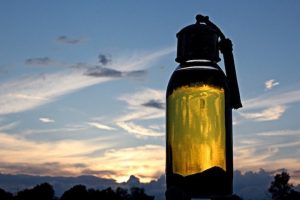Glossary
Glossary - Argan oil, liquid gold for the skin

Jul
Argan oil has long been a firm favourite in skin and hair care. This heavy, bitter-smelling oil is literally liquid gold. Here we explain what argan oil is made from, why it is the most expensive oil in the world and how to use it correctly.
Argan oil is extracted from the kernels of the argan tree (argania spinosa) and is a true luxury product: the argan tree is one of the rarest trees in the world. As it grows mainly in Morocco, the oil is sometimes also called Moroccan oil.
:

:
The argan tree has been growing since the Tertiary period (65 to 1.8 million years ago). At that time, North Africa was extensively populated with argan trees - today, however, the argania spinosa is an endangered species and is protected by UNESCO. The argan tree can grow up to 10 metres high and develops thorns, a gnarled trunk and long, oval leaves. The argan tree blossoms in April and it takes over a year for the flowers to ripen into argan fruit (around May-June of the following year). Each tree ripens about 8kg of argan fruit in a year - so it takes about 8 argan trees to produce one litre of argan oil. For this reason, argan oil is probably the rarest oil in the world.
:

:
The oil of the unroasted argan seeds is used for skin care, skin diseases, hair care, but also as a delicacy on salads and other dishes. It contains tocopherol (vitamin E), phytosterols, polyphenols, ferulic acid, carotenoids, squalene and the following fatty acids:
44% Oleic acid
30% Alpha-linolenic acid
12% Palmitic acid
6% Stearidonic acid
5% Linoleic acid
3% Myristic acid
Argan oil is therefore rich in unsaturated fatty acids (approx. 80%), essential fatty acids and antioxidants. Essential fatty acids are also contained in the cell membrane and are therefore also responsible for regulating skin health and, in particular, premature ageing. Vitamin E, another major component of argan oil, is a powerful antioxidant that protects the essential fatty acids as well as the vitamin A balance in the body and skin. Vitamin E accumulates in the epidermis (the outermost layer of the skin) and forms a barrier that locks in moisture, prevents skin ageing through oxidation, has an anti-inflammatory effect and strengthens the capillary walls. Argan oil is therefore also used to visibly reduce scars and stretch marks.
The squalene, vitamin E and essential fatty acids contained in argan oil also make this liquid gold an emollient (makes the skin soft and smooth) and is quickly absorbed by the skin.
Argan oil as a cosmetic
Argan oil is a particularly popular ingredient in hair care products. The pure argan oil forms a layer around the hair that locks in moisture and gives the hair a healthy shine, making it look silky and smooth, while the oil strengthens the hair shaft. Argan oil also protects the hair from heat from styling tools or the sun. Because the molecules of argan oil are small enough to penetrate the cortex of the hair (as is the case with coconut oil, for example), damaged hair can actually be repaired by using argan oil. Argan oil also prevents hair loss, prolongs the life of hair follicles and stimulates hair growth by producing keratin. For these reasons, argan oil is also used for nail care.
As described above, argan oil is one of the most healing and protective ingredients for skin care due to its exceptional properties, moisturising, counteracting inflammation, healing wounds, anti-pediculosis, anti-ageing and rebalancing sensitive and blemished skin that is also dry.
Argan oil is therefore excellent for dry, reddened and flaky skin, can be mixed into make-up during the cold season, applied to scars and small burns and used as a hair treatment in combination with a hydrosol. Finally, argan oil can also be enjoyed as an exotic oil for salads, steamed mushrooms or on avocado fennel.
Argan oil is here available.
:
photo credit: linahansonblog.wordpress.com, claycarau.wordpress.com, femita.com
Parts of this article were first published on www.thetwist.ch the predecessor of Biomazing.